 Gilman Studio On-Line Lessons
Gilman Studio On-Line Lessons
Yang Style Long Form
Tai Chi Chuan
This Lesson Contains:
Common Errors in the First Section
Tai Chi Chuan is a very complex martial art/chi kung exercise. Everybody learns from a teacher and each teacher thinks that he or she knows a good, if not the best, way to do Tai Chi. I have over 30 years experience with the art and I have worked with thousands of students. I know well many of the most common errors in the form. Most come from not thinking about Tai Chi as a martial art, and thereby doing postures that would not work as a self-defense. Some errors are actually harmful if repeated often. I have tried to pick out mistakes that most people seem to make. Please pay close attention to what you are doing, monitor yourself, and you will end up with something very valuable that can never be taken away from you.
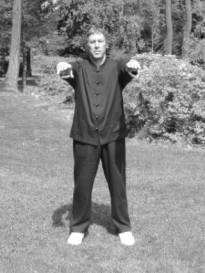
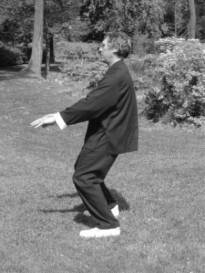 Commencement Of Tai Chi Chuan – #1
Commencement Of Tai Chi Chuan – #1
Two of the most common errors in this movement are raising the shoulders when raising the arms and leaning back when squatting. Raising the arms disconnects the arms from the center as the energy gets stuck in the shoulders. Try holding this posture for a few minutes and you will soon feel tension in the shoulders and upper back. Let the shoulders and elbows droop always.
Leaning back places much stress on the low back and blocks the energy from being able to enter the Kua. The weight shifts to the rear of the foot instead of falling in the front /center called the Bubbling Well Point. You could be easily pushed backwards.
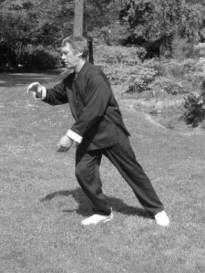
 Ward Off Left – #2
Ward Off Left – #2
Leaning and turning too far are common problems with this movement.
In the first picture, I have turned too far to the right and am leaning in that direction. I am unstable in my relationship to the opponent who is in front of me. There is stress on my right knee and also on the low back. Always keep the spine straight up and down and do not turn away from opponent.
In the second picture, I am leaning back as I step. I cannot use the Kua to gather and disperse energy when leaning back. I can easily be pushed backwards. There is stress in the low back. It is possible to step out of the right foot root when leaning back.
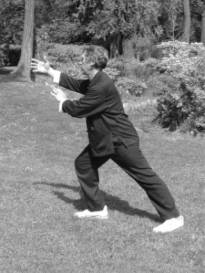
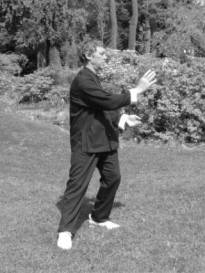 Right Push Upward and Roll Back – #3
Right Push Upward and Roll Back – #3
In the first picture of Right Push Upward, I am over-extended, and leaning. There is stress on my right knee, the arms are losing connection to my center, and I am easily pulled forward because I am not rooted into the right foot.
The second picture, Roll Back, shows the results of turning too far to the left. The right leg is twisted and has lost most of the root. My nose has moved to the left of my knee, causing stress throughout the torso and I can easily be pushed off balance with a press to my center. It is important to keep the idea of an opponent in order to have the body in proper relation to it.
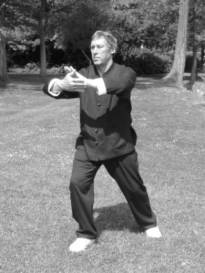 Press – #5
Press – #5
Press is a powerful movement, probably the most powerful and effective for the Tai Chi player. The energy comes up from the ground to the Kua, then straight up the spine to the area between the shoulders, and finally released from both arms and focused in quite a small area. Because of the nature of Tai Chi as a martial art and our desire to be relatively close to our opponent, Press in very useful and often used. When playing Push Hands, Press is difficult to defend against.
The most common error in this posture is to raise the elbows and shoulders. The result is almost a total blockage of the flow of energy coming out of the intended area of release. First the energy gets stuck in the shoulders and what is left gets blocked in the elbows. If one were to use Fa Jin or powerful releasing energy with the body in this posture, one could easily injure oneself and not do anything to the opponent.
Always keep the shoulders and elbows drooped.
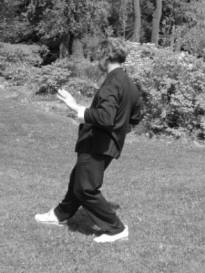
 Push- #6
Push- #6
Push seems to be quite a simple movement, yet few do it correctly. These two pictures illustrate some of the common problems.
In the first picture, I am leaning back and the elbows have gotten behind the body. When leaning, I can’t transfer incoming energy into my left Kua for storage. My low back is trying to deal with holding back any force directed at me, instead of letting my leg and foot root the force. When the elbows get behind the body, the shoulders are stressed. If I was dealing with force, I could easily be pushed back.
In the second picture I am pushing from the shoulders, not the center of the body and I am leaning. If I was pulled, I couldn’t deal with it, as I have no forward root.
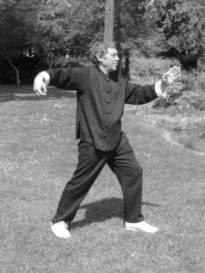 Single Whip – #7
Single Whip – #7
Single whip is a beautiful and important movement in Tai Chi. It is repeated 10 times throughout the long form. In traditional Yang Style, each single whip is the same as the rest. I have 10 different applications, hence 10 different ways the movement is performed.
There are many possible problems associated with this movement. Two of the most obvious are illustrated here and below, that of letting the energy get stuck in the shoulder, and of having too narrow a stance.
In the picture at left, my shoulder is raised and the elbow does not droop down resulting in a tight neck and raised center of gravity. The energy is stuck in my neck and shoulder. I would not be able to whip out the energy into the right hand. Keep the shoulders and elbows drooped.
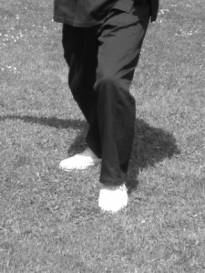
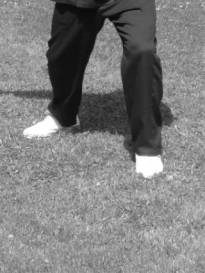 Single Whip – #7
Single Whip – #7
I am illustrating a narrow stance for Single Whip in the picture on the left, and the correct stance on the right. If you look at the application of this movement in lesson #7, you will see that I am leading the opponent’s energy to the left with my left hand and attacking her center with my right hand whip. If I did this with the narrow stance, I would have very little lateral stability. I need a wider base on which to balance. The stance on left might be good for a straight- forward movement with no twisting, but not here.

 Raise Hands – #8
Raise Hands – #8
Raise Hands is one of the meditative standing postures used to gain strength, relaxation, and energy movement. It is important to have all parts of the body in the proper relationship.
Firstly, the right toe is raised off the ground too far, resulting in tension along the front of the shin.
Secondly, the two hands do not relate. This movement uses “crushing strength”, like a vise. The energy should come out of the heel of the hands, with arms, forearms, and hands having the same angle. Look back to lesson #9 to see how to do this correctly.
You might want to try using Raise Hands for standing, holding as long as you feel comfortable, and then switch sides. In a short while, you will feel energy movement.
 Stork Spreads Its Wings – # 9
Stork Spreads Its Wings – # 9
Here I am leaning back, with the resulting loss of root in my right foot. I am not using the right Kua to store energy. The right arm is slightly behind the body, resulting in shoulder strain and loss of the proper idea for the application presented for this movement.
In lesson #10, I demonstrated the use of the right arm to strike or hook around the opponent. That would not be possible with the arm behind the body.

 Left Brush Knee – #10
Left Brush Knee – #10
Brush Knee is a useful movement when done correctly. In the picture on the left, I am making a few mistakes. Firstly, I am too far back on my right hip and leg, so I have lost the use of the Kua energy. The right hand is too far to the rear so there is a loss of power when striking or pushing. The left hand has brushed the left knee too soon, leaving my center open. The brush happens just before the release of the right hand.
In the picture on the right, I am leaning forward. The balance is shifted to the ball and toes of the left foot, resulting in loss of root. The right arm is too straight with the shoulder and elbow not drooped. I could easily be pulled forward as there is no slack in the right arm.
 Play the Fiddle – #11
Play the Fiddle – #11
There are several problems with this movement. I am standing up on my right leg instead of staying at the same level as all other movements. In this form, once the body is lowered in Commencement, the body always stays at the same level, except for Cross Hands and Conclusion.
I have lost the energy of the right Kua. The left toe is too far off the ground, so there is tension on the left shin. The two hands do not relate, which results in a reduced chi flow.
On the surface, this movement might look all right, but once you look closely, there are many problems. It takes years to find and correct all the many problems that creep into one’s form.

 Step Up, Parry, Punch – #17
Step Up, Parry, Punch – #17
Punches are most effective when done using the whole body. Also, we don’t want to telegraph that we are going to punch. In both these pictures I have drawn the punching arm behind the body, making it obvious that a punch is coming. The punch will lose power because the torso can’t push the punch from the rear. It first must pull the arm to get the arm in a position to put power behind it.
If you look back at lesson#17, you will notice that the punching arm is at the side of the body. Any movement of the body to the left will send the punch forward. The legs and torso do the punch, not the arms. Always keep the fist pointing in the direction it will end up going, like the barrel of a gun.

 Withdraw and Push – #18
Withdraw and Push – #18
One of the Tai chi principles states,” if you want to push, first you must pull.” This movement expresses that principle, but these mistakes will lead to trouble.
In the picture on the left, I have withdrawn and pulled my opponent in order to uproot him. The way I have done it here would result in partner falling on me since I have allowed the arms to get behind the body and I am leaning back. I would not be able to gather energy into my right Kua for later release.
In the second picture, I am pushing, but have not fully expressed the power of the movement. The weight is not far enough forward onto the left foot. Pushes come from the legs and mostly the front foot. Here my left leg is not doing anything.

 Cross Hands – #19
Cross Hands – #19
Cross Hands is the conclusion of the first section and is mostly used to gather the energy that has been generated so far.
In the picture on the left, the two arms have lost their connection. Done correctly, this part of the movement is done with a feeling of pulling a strong rubber band apart with the two arms. This collects the energy into the upper body, which will then be gathered into the center.
In the picture on the right I have come up, but there is a lack of Peng Jin or expanding energy from the feet into the arms. The movement lacks power. This is a special moment when we get to experience the fullness of accumulated energy. Let it express itself in your posture.
